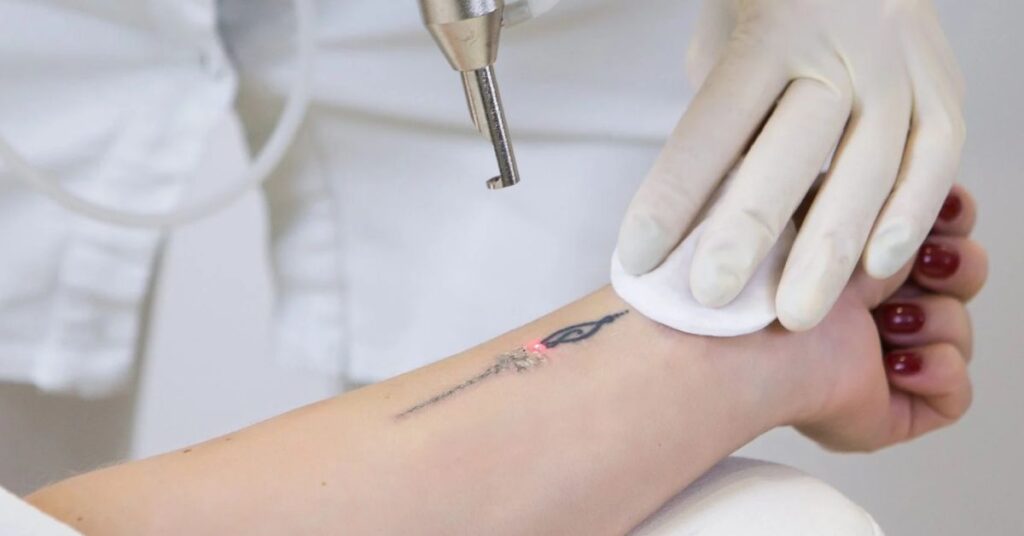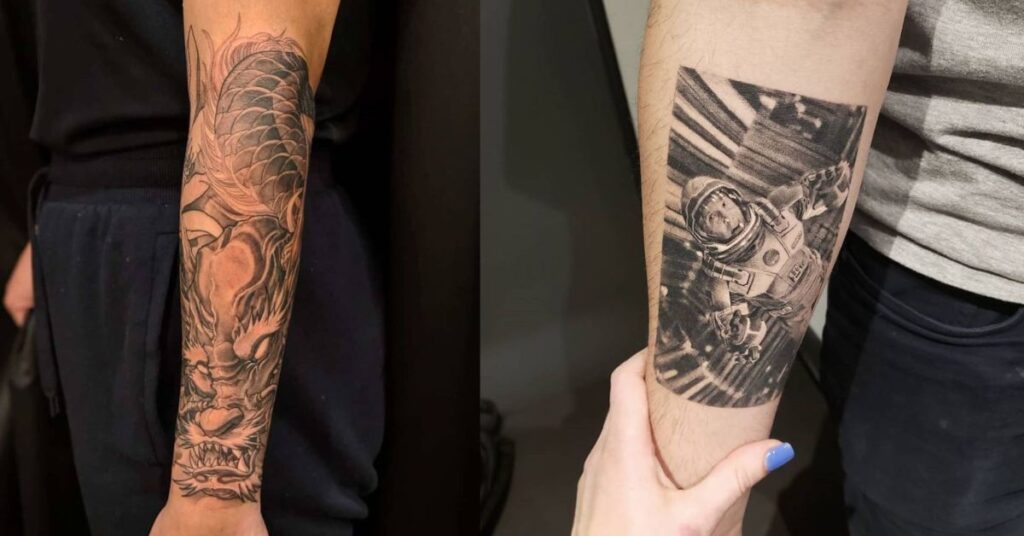Forearm tattoos are designs on the lower part of your arm. They’re popular and visible. Forearm tattoos can be less painful compared to other body parts. People choose them for their accessibility and versatility.
Curious about forearm tattoos. Wondering if they cause pain. Let’s explore further. Forearm tattoos are quite popular, but do they hurt. This is a common inquiry. But worry not, we’re here to shed light on the matter. Prepare yourself for some enlightening insights.
Interested in forearm tattoos. Wondering if they cause pain. Let’s delve into the truth. Forearm tattoos are trendy, but does getting one hurt. Many ponder this question. But fear not, we’ve got answers. Brace yourself as we uncover the reality. Get ready to discover the pain factor.
Do Forearm Tattoos Hurt?
Forearm tattoos, a popular choice for their visibility, typically cause mild discomfort during the tattooing process. The pain level varies based on individual tolerance and the tattoo’s location. Generally, forearm tattoos are less painful due to thicker skin and fewer nerve endings compared to other body parts.
Proper preparation, such as adequate rest and hydration, can help minimize discomfort. Overall, while some discomfort is expected, forearm tattoos are manageable for most individuals.
Read this Blog: Sithelo Shozi Biography: Age, Baby Daddy, Kids, Booking Fee, Boyfriend, Surgery, Car
Pain Comparison: Forearm Vs Other Areas

Here’s a table with detailed explanations comparing the pain of forearm tattoos to other body areas:
| Body Area | Pain Level | Explanation |
| Forearm | Mild to moderate discomfort | Forearm tattoos typically cause less pain due to thicker skin and fewer nerve endings. |
| Ribs | Moderate to severe pain | Rib tattoos can be more painful due to the proximity of the bones and thinner skin. |
| Feet | Moderate to severe pain | Tattoos on the feet are often more painful due to the lack of padding and numerous nerve endings. |
| Wrists | Moderate discomfort | Wrist tattoos may cause moderate discomfort, especially near the bones and tendons. |
| Inner Bicep | Moderate discomfort | Inner bicep tattoos can be moderately painful due to sensitive skin and proximity to muscles. |
| Spine | Moderate to severe pain | Spinal tattoos are often more painful due to the proximity of the bones and nerve endings. |
Overall, forearm tattoos tend to be less painful compared to other areas of the body.
Forearm Tattoos for First-Time Recipients
For first-time recipients, forearm tattoos offer a less intimidating experience. These tattoos typically cause mild discomfort due to the thicker skin and fewer nerve endings in the forearm region. However, it’s crucial to consider factors such as pain tolerance, design complexity, and placement before getting inked.
While forearm tattoos are easy to show off and provide a good starting point for beginners, they may fade faster due to sun exposure. Potential job considerations and limited space for design are also important factors to weigh.
| Factors | Pros | Cons |
| Pain Level | Mild discomfort | Potential fading due to sun exposure |
| Visibility | Easy to show off | Limited space for design |
| Beginner-Friendly | Good for beginners | Potential job considerations |
| Healing Time | Tattoos heal relatively fast | Placement may affect healing process |
| Design Options | Versatile canvas for various designs | Limited space and curvature may restrict design options |
Overall, while forearm tattoos offer several advantages for first-time recipients, it’s essential to consider both the pros and cons before getting inked.
Read this Blog also: Best Eyelash Extensions Styles For Different Eye Shapes.
How To Prepare For The Tattoo Procedure?

Several Days Before the Procedure:
- Hydrate: Start increasing your water intake a few days before the tattoo appointment to ensure your skin is well hydrated. Hydrated skin is more pliable and can help the tattooing process go smoother.
- Rest: Aim to get adequate sleep in the nights leading up to the appointment. Quality sleep helps your body recover and prepares you mentally and physically for the procedure.
The Day Before the Procedure:
- Eat Nutritious Meals: Consume balanced meals rich in vitamins and minerals to support your immune system and promote faster healing.
- Avoid Alcohol and Caffeine: Refrain from consuming alcohol and excessive caffeine, as they can thin your blood and increase bleeding during the tattooing process.
- Plan Your Outfit: Choose comfortable clothing that allows easy access to the area where you’ll be getting tattooed. Avoid tight clothing that may rub against the fresh tattoo.
The Morning of the Procedure:
- Hydrate: Drink water to maintain hydration levels, but avoid excessive caffeine or sugary drinks that may cause dehydration.
- Eat a Light Meal: Have a light, balanced meal a few hours before your appointment to ensure you have enough energy without feeling overly full.
- Gather Necessary Items: Bring any required identification, payment, or forms provided by the tattoo studio. Additionally, consider bringing a snack or drink for after the procedure.
During the Procedure:
- Communicate with Your Artist: Stay in constant communication with your tattoo artist. Share any concerns or discomfort you may be experiencing during the process.
- Stay Relaxed: Practice deep breathing or other relaxation techniques to help manage any discomfort or anxiety during the tattooing process.
By following these steps and considering time factors, you can effectively prepare for a tattoo procedure and ensure a smooth and successful experience.
Pain Perception During Tattoo Sessions
Varies Among Individuals: Pain perception during tattoo sessions differs from person to person based on factors like tolerance and sensitivity.
Influenced by Session Length: Longer tattoo sessions may lead to increased discomfort as the body fatigues over time.
Affected by Physical Condition: Your overall physical health and well-being can impact how you perceive pain during a tattoo session.
Complexity of Tattoo Design: Intricate designs with fine details may cause more discomfort as the needle repeatedly penetrates the skin.
Management Techniques: Employ pain management techniques like deep breathing or distraction to help alleviate discomfort during the session.
Communication with Artist: Communicate openly with your tattoo artist about any discomfort or pain you experience during the session.
Tips for Easing Tattoo Discomfort
- Use numbing creams to reduce pain sensation during tattoo sessions.
- Opt for distraction techniques such as listening to music or engaging in conversation.
- Practice deep breathing exercises to help relax and manage discomfort.
- Choose a comfortable position that allows you to remain still during the tattooing process.
- Stay hydrated and avoid caffeine or alcohol before your appointment to minimize sensitivity.
- Communicate openly with your tattoo artist about any discomfort you’re experiencing for adjustments.
Do Inner Forearm Tattoos Hurt?
Inner forearm tattoos can cause discomfort due to the sensitive skin and proximity to bones. The inner forearm has less muscle padding compared to the outer forearm, making the sensation more intense. However, pain tolerance varies from person to person.
Factors such as individual pain threshold, tattoo placement, and design complexity influence the level of discomfort experienced. It’s advisable to communicate openly with your tattoo artist about any discomfort during the session.
Additionally, techniques like deep breathing and distraction can help manage pain. Ultimately, while inner forearm tattoos may be more uncomfortable for some, proper preparation and communication can contribute to a smoother tattooing experience.
Frequently Asked Questions
What Are Some Common Forearm Tattoo Designs for First-Timers?
Common forearm tattoo designs for first-timers include arrows, compasses, and meaningful symbols like hearts or initials.
Are There Any Specific Aftercare Instructions for Forearm Tattoos?
Aftercare for forearm tattoos involves regular cleaning, using antibacterial products, and keeping the tattoo moisturized to prevent infection.
How Long Does a Typical Forearm Tattoo Take to Heal Completely?
Forearm tattoos typically take about two weeks to heal completely, although individual healing times may vary.
What Factors Might Affect Pain Experienced During a Forearm Tattoo Session?
Pain experienced during a forearm tattoo session can be influenced by factors such as individual pain threshold, tattoo placement, and design complexity.
How badly do forearm tattoos hurt?
Forearm tattoos usually cause mild discomfort, with pain levels varying based on individual tolerance.
Where does tattoo hurt the least?
Areas with more flesh, like the outer forearm, tend to hurt less during tattooing.
What is the most painful area to get a tattoo?
The ribs, feet, and inner thighs are considered among the most painful areas to get tattoos.
What does tattoo pain feel like?
Tattoo pain can feel like a scratching or stinging sensation, similar to a prolonged sunburn or cat scratch.
Conclusion
Forearm tattoos typically cause mild discomfort but are manageable for most individuals. Factors such as pain tolerance, tattoo placement, and design complexity influence the level of discomfort experienced. It’s essential to prepare adequately before getting a tattoo, ensuring you’re mentally and physically ready for the experience.
Techniques like deep breathing and distraction can help manage pain during the tattooing process. Remember to communicate openly with your tattoo artist about any discomfort you may experience. Aftercare is also crucial for promoting proper healing and preserving the tattoo’s vibrancy. With the right mindset and preparation, you can wear your forearm tattoo with pride, a beautiful representation of your personal style and strength. So, embrace the journey and enjoy your new body art.

Grayson, with 5 years of expertise in fashion, brings unparalleled creativity and insight to our website. His keen eye for trends elevates our content to new heights.







